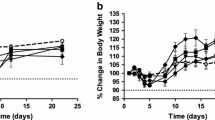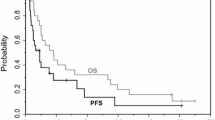Abstract
N-[2-(Dimethylamino)ethyl]acridine-4-carboxamide (DACA), a DNA intercalator that exerts its antitumour action through the enzyme topoisomerase II, has previously been shown to be curative against the transplantable Lewis lung adenocarcinoma growing as lung tumour nodules in mice. On the basis of this finding as well as its high in vitro activity against multidrug-resistant cell lines, DACA has been chosen for clinical trial under the auspices of the Cancer Research Campaign, United Kingdom. In the present study the activity of DACA was assessed against advanced (5-mm diameter) s.c. colon 38 adenocarcinomas in BDF1 mice using tumour-growth delay as an end point. Its activity was found to be related positively to the total dose given and negatively to the total duration of the dose schedule. Adoption of a split-dose i.p. administration schedule or slow i.v. infusion allowed the administration of large doses without toxicity. The activity of DACA was comparable with that of 5-fluorouracil and superior to that of doxorubicin, cyclophosphamide and the experimental amsacrine analogue CI-921. Mitoxantrone, amsacrine, etoposide, teniposide and daunorubicin showed minimal activity. DACA also demonstrated significant activity against the NZM3 melanoma human cell line growing as a xenograft in athymic mice.
Similar content being viewed by others
References
Atwell GJ, Rewcastle GW, Baguley BC, Denny WA (1987) Potential antitumor agents. 50. In vivo solid tumor activity of derivatives ofN-[2-(dimethylamino)ethyl]acridine-4-carboxamide. J Med Chem 30:664–669
Baguley BC (1991) DNA intercalating anti-tumour agents. Anticancer Drug Des 6:1–35
Baguley BC, Kernohan AR, Wilson WR (1983) Divergent activity of derivatives of amsacrine (m-AMSA) towards Lewis lung carcinoma and P388 leukaemia in mice. Eur J Cancer Clin Oncol 19:1607–1613
Baguley BC, Denny WA, Atwell GJ, Finlay GJ, Rewcastle GW, Twigden SJ, Wilson WR (1984) Synthesis, antitumor activity, and DNA binding properties of a new derivative of amsacrine,N-5-dimethyl-9-[(2-methoxy-4-methylsulfonylamino)-phenyl-amino]-4-acridinecarboxamide. Cancer Res 44:3245–3251
Baguley BC, Calveley SB, Crowe KK, Fray LM, O'Rourke SA, Smith GP (1989) Comparison of the effects of flavone acetic acid, fostriecin, homoharringtonine and tumour necrosis factor α on Colon 38 tumors in mice. Eur J Cancer Clin Oncol 25:263–269
Baguley BC, Finlay GJ, Ching LM (1992) Resistance mechanisms to topoisomerase poisons—the application of cell culture methods. Oncol Res 4:267–274
Ching LM, Finlay GJ, Joseph WR, Baguley BC (1990) Comparison of the cytotoxicity of amsacrine and its analogue CI-921 against cultured human and mouse bone marrow tumour cells Eur J Cancer 26:49–54
Corbett TH, Griswold DP, Roberts BJ, Peckham JC, Schabel FM (1977) Evaluation of single agents and combinations of chemotherapeutic agents in mouse colon carcinomas. Cancer 40:2660–2680
Cornford EM, Young D, Paxton JW (1992) Comparison of the blood-brain barrier and liver penetration of acridine antitumor drugs. Cancer Chemother Pharmacol 29:439–444
Evans SMH, Young D, Robertson IGC, Paxton JW (1992) Intraperitoneal administration of the antitumour agentN-[2-(dimethylamino)ethyl]acridine-4-carboxamide in the mouse: bioavailability, pharmacokinetics and toxicity after a single dose. Cancer Chemother Pharmacol 31:32–36
Ferguson LR, Baguley BC (1993) Identification of analogues of the antitumour drug amsacrine which are highly mutagenic to the yeastSaccharomyces cerevisiae. Genetics [Life Sci Adv] 12:1–6
Haldane A, Finlay GJ, Gavin JB, Baguley BC (1992) Unusual dynamics of killing of cultured Lewis lung cells by the DNA-intercalating antitumour agentN-[2-(dimethylamino)ethyl]acridine-4-carboxamide. Cancer Chemother Pharmacol 29:475–479
Liu LF (1989) DNA topoisomerase poisons as antitumour drugs. Annu Rev Biochem 58:351–375
Marshall ES, Finlay GJ, Matthews JHL, Shaw JHF, Nixon J, Baguley BC (1992) Microculture-based chemosensitivity testing: a feasibility study comparing freshly explanted human melanoma cells with human melanoma cell lines. J Natl Cancer Inst 84:340–345
Marshall ES, Holdaway KM, Shaw JHF, Finlay GJ, Matthews JHL, Baguley BC (1993) Anticancer drug sensitivity profiles of new and established melanoma cell lines. Oncol Res 5:301–309
Paxton JW, Young D, Evans SMH, Kestell P, Robertson IGC, Cornford EM (1992) Pharmacokinetics and toxicity of the antitumour agentN-[2-(Dimethylamino)ethyl]acridine-4-carboxamide after i.v. administration in the mouse. Cancer Chemother Pharmacol 29:379–384
Paxton JW, Young D, Evans SMH, Robertson IGC, Kestell P (1993) Tumour profile ofN-[2-(Dimethylamino)ethyl]acridine-4-carboxamide after intraperitoneal administration in the mouse. Cancer Chemother Pharmacol 32:320–322
Schneider E, Darkin SJ, Lawson PA, Ching L-M, Ralph RK, Baguley BC (1988) Cell line selectivity and DNA breakage properties of the antitumour agentN-[2-(Dimethylamino)-ethyl]acridine-4-carboxamide: role of DNA topoisomerase II. Eur J Cancer Clin Oncol 24:1783–1790
Wilson WR (1992) Tumour hypoxia: challenges for cancer chemotherapy. In: Waring MJ, Ponder BAJ (eds) Cancer biology and medicine, vol 3. The search for new anticancer drugs. Kluwer, Lancaster, pp 87–131
Author information
Authors and Affiliations
Rights and permissions
About this article
Cite this article
Baguley, B.C., Zhuang, L. & Marshall, E. Experimental solid tumour activity ofN-[2-(dimethylamino)ethyl]-acridine-4-carboxamide. Cancer Chemother. Pharmacol. 36, 244–248 (1995). https://doi.org/10.1007/BF00685854
Received:
Accepted:
Issue Date:
DOI: https://doi.org/10.1007/BF00685854




